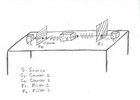Entangled photon's can be considered as a photon-pair with the property that the angle between the two planes (of each photon) is 90 degrees.
The behavior of the photon's is studied by means of experiments in different configurations. The experiment consists of one source, two counters and two filters.
Before each counter is a filter. Filter 1 is always in the same position (0 degrees). Filter 2 can be in different positions (0, 45 and 90 degrees)
If the photon is counted depents on the filter angle and the plane of the photon as follows:
- When the filter angle is 0 the photon is counted when the plane of the photon is between -45 and 45 degrees.
- When the filter angle is 90 the photon is counted when the plane of the photon is between 45 and 135 degrees.
- When the filter angle is alpha the photon is counted when the plane of the photon is between alpha-45 and alpha+45 degrees.

|
The experiment is performed in 9 different configurations:
- Source in the middle - Distance between Counter 1 and Counter 2 short - No filters
- Same as 1 except with filters - Filter 1 angle 0 degrees Filter 2 angle 0 degrees
- Same as 1 except with filters - Filter 1 angle 0 degrees Filter 2 angle 90 degrees
- Source in the middle - Distance between Counter 1 and Counter 2 long - No filters
- Same as 4 except with filters - Filter 1 angle 0 degrees Filter 2 angle 0 degrees
- Same as 4 except with filters - Filter 1 angle 0 degrees Filter 2 angle 90 degrees
- Source not in middle - Distance between Counter 1 and Counter 2 asymetric (one short on long) - No filters
- Same as 7 except with filters - Filter 1 angle 0 degrees Filter 2 angle 0 degrees
- Same as 7 except with filters - Filter 1 angle 0 degrees Filter 2 angle 90 degrees
Each experiment consists of 1000 events, that means 1000 photon pairs are created. The results are studied by means of two camera's
The distance short means for example 2m. The distance long 1000m.
This should be the only difference. If the short distance is done without fiber optics cables than the long distance should also be done without.
It is also possible to perform the test with fiber optics but than both the short and the long setup should contain fiber optics in all 9 configurations.